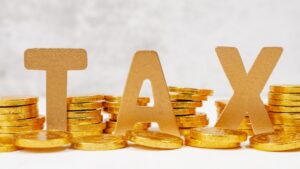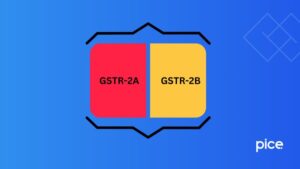How to Calculate CGST and SGST?
- 1 Sep 24
- 8 mins
How to Calculate CGST and SGST?
Key Takeaways
- GST simplifies tax calculation by unifying various taxes into a single system, with rates categorized across seven schedules.
- CGST and SGST are levied equally on intrastate transactions, while IGST applies to interstate transactions.
- GST calculators online can accurately determine CGST, SGST, and IGST, reducing the risk of human errors in tax computation.
- Certain goods and services, such as alcoholic beverages and petroleum products, remain outside the GST framework, taxed by state governments.
- The GST exclusive price represents the cost before tax, essential for businesses to understand their pre-GST supply costs.
Under the Goods and Services Tax (GST) Act, goods and services are divided into 5 distinct tax rates: 0%, 5%, 12%, 18% and 28%. There are certain products and services that exist to which GST does not apply at all. In addition, most supplies are separately taxed by individual state authorities as well as the Central Government.
However, in case you have ever wondered how to calculate CGST and SGST then this summarised guide is intended to assist you.
What Is GST?

The Goods and Services Tax, commonly known as GST, is a form of indirect tax that is imposed on the supply of products and services made within India. As several times value addition of supplies occurs, the GST keeps on being modified and is thus identified as a multi-stage indirect tax reform.
Nevertheless, there are some selected items like alcoholic drinks, petroleum products and electricity supply that are not taxed under the GST regime. Individual state governments levy tax rates on these supplies as per the old tax regulations.
What Are the 3 Types of GST Collected by the Government?
Primarily, GST has been categorised under three heads:
- Central Goods and Services Tax (CGST)
- State Goods and Services Tax (SGST)
- Integrated Goods and Services Tax (IGST)
In union territories, there is a separate set of rules as mentioned under the Union Territory Goods and Services Tax or UTGST.
The third type as mentioned in the list i.e., IGST is attributed during interstate transactions. In simple words, when the recipient is present in any other state compared to the supplier, then IGST is levied. For intrastate supplies (when both the supplier and the place of supply are in the same state), the GST is split equally between CGST and SGST, which is roughly half of the IGST rate.
For example, if you sell something within the state, 50% of the GST will be CGST and 50% of the GST will be SGST. However, as soon as you sell something outside your state, 100% of it will be IGST which goes to the Central Government.
GST Calculator Advantages for Businesses

By using a GST calculator online, any registered taxpayer can compute their monthly or quarterly payable tax accurately without having to apply any complex formulae. Hence, these online tools prove to be very useful for manufacturers, wholesalers and even regular buyers eliminating human errors.
GST calculators assist in bifurcating the rates between CGST and SGST. In addition, you can determine the payable IGST precisely after listing down all the interstate transactions.
GST Rates
As per the latest regulations, the GST rate slabs for goods have been divided among 7 different schedules:
| Schedules | GST Rate |
| Schedule I | Nil |
| Schedule II | 0.25% |
| Schedule III | 3% |
| Schedule IV | 5% |
| Schedule V | 12% |
| Schedule VI | 18% |
| Schedule VII | 28% |
Each schedule lists specified goods in two columns: "Chapter/Heading/Sub-heading/Tariff Item," which details the HSN Codes, and Description of Goods, which offers a unique identification of the goods to aid businesses.
Formulae for GST Calculation
The GST calculation formula is very straightforward. Depending on the tax category, i.e., nil, 5%, 12%, 18% or 28%, the net payable price is sorted out for a particular supply.
The mathematical formula used in GST calculation is as follows:
Net Price = Selling Price + (Selling Price × 100\GST Rate)
For instance, if you have bought a product priced at ₹720 that attracts 12% GST, then the total amount you owe the supplier would be ₹806.40.
How to Calculate GST Using Formula?
After the revised taxation norms came into force, the calculation process of GST has become manifold easier. Based on the nature of the transaction, i.e., whether interstate or intrastate, the applicable GST can be measured as follows:
- Inter-state GST Tax Calculator
These GST taxes are stipulated as per the latest announced rates. However, you must note that wherever applicable, GST Compensation Cess is taken into consideration to rectify tax calculations. A virtual GST credit calculator is based on similar features.
Thus, for inter-state supplies, the applicable GST amount = (Original Expense * GST Rate Percentage) / 100. Consequently, the net price is computed by adding the GST amount to the original cost.
- Intra-state GST Tax Calculator
For intra-state sales, the following rules apply:
- CGST = GST rate applicable / 2
- SGST = GST rate applicable / 2
Thus, the State and Central Governments collect equal shares of tax.
Example for CGST and SGST With Calculation
Here's a quick example of CGST and SGST calculation:
Suppose you bought a laptop within your state worth ₹80,000. In this case, the GST rate applicable would be 18%. Hence, the cumulative GST that you will owe to the supplier is ₹14,400.
In the end, the final sale price of the laptop will be ₹94,400. Here, the CGST and SGST will be divided equally.
- CGST = ₹14,400 / 2 = ₹7,200
- SGST = ₹14,400 / 2 = ₹7,200
Note: SGST and CGST are not attributed to interstate supplies or transactions.
Inclusive GST Calculator
Wherever you see a ‘price inclusive’ tag, you would need to use a reverse GST calculator. Like the formulae we discussed before, this one is also very simple.
- GST Amount = GST Inclusive Price * GST Rate /(100 + GST Rate Percentage)
- Original Cost = GST Inclusive Price * 100/(100 + GST Rate Percentage)
What Is the GST Exclusive Amount?

The GST exclusive price denotes the cost of supplies without considering the applicable GST rates on them. For business owners who want to precisely calculate the supply price before GST, it is essential to assimilate the concept of GST exclusive amount.
Tabular Difference Between the Four Types of GST Tax Heads
Here is the complete list of differences among the various categories of GST:
| GST Type | Parameters | |||
| Tax Collecting Authority | Priority of Credit Usage | Applicable Transactions | Benefiting Body | |
| IGST | Central Government | IGST, CGST, SGST | Inter-state transactions | State Government and Central Government |
| CGST | Central Government | CGST, IGST | Intra-state transactions | Central Government |
| SGST | State Government | SGST, IGST | Intra-state transactions | State Government |
| UGST | Union Territory Government | UTGST, IGST | Transaction taking place within that UT | Union Territory (UT) Government |
All these GST classes have successfully replaced a bunch of other taxes like purchase taxes, luxury taxes, service taxes, entertainment taxes, VAT, etc. that were previously levied both by the state and the centre.
Conclusion
We hope that this blog has provided you with a clear idea of how to calculate CGST and SGST. Additionally, you have learnt to calculate GST in cases of a reverse charge. Thus, you may take the help of an online calculator from now on to check net tax liabilities under individual tax heads.
💡If you want to pay your GST with Credit Card, then download Pice Business Payment App. Pice is the one stop app for paying all your business expenses.
 By
By 














